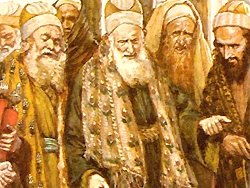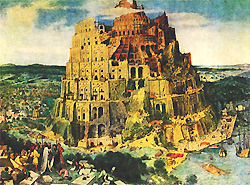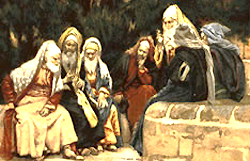From the Judaic history: who were the Pharisees
By Victor Ardeleanu
Motto: “The ones who did not understood history will repeat it”
 Words like “Pharisee” or “…” entered the common language a long time ago to define rather qualities than historical realities. The DEX dictionary defines the term “Pharisee” as hypocrite, liar, perfidious, false, sly person, artful…..; on the other side, it is sometimes used in the meaning of fanatic. Behind these meanings there is a long history, however. We will try to discover together only a few from the inciting aspects from the Judaic history, and we will discover that both the Pharisees and … represent “sects”, meaning separate groups from the Judaic religion.
Words like “Pharisee” or “…” entered the common language a long time ago to define rather qualities than historical realities. The DEX dictionary defines the term “Pharisee” as hypocrite, liar, perfidious, false, sly person, artful…..; on the other side, it is sometimes used in the meaning of fanatic. Behind these meanings there is a long history, however. We will try to discover together only a few from the inciting aspects from the Judaic history, and we will discover that both the Pharisees and … represent “sects”, meaning separate groups from the Judaic religion.
In ancient Israel, like in other societies from those times, the rectory institution is strongly connected with the politics and royals institutions. After a period of decentralized and non-institutionalized political authority, according to the sacred texts (Tanakh – Jewish Bible), recorded and described in the Book of Judicators, the children of Israel asked God to give them a king. Samuel (the last Judicator) anointed then Saul as king, followed by David, the first from the royal line of Israel – the House of David.
The first and second Temple
The religious authority of the priests was centralized and institutionalized once with the building of the first temple from Jerusalem around the year 950 B.C. During the “Period of the First Temple” (950-586 B.C.) the priests served in the temple and read sacred texts. The political power was owned by the king, but he had to be anointed by the Great Priest, as a sign of the divine right – given to a human being – to govern. The authority of the priests was based on the sacred texts which contained moral stories, teachings, laws, ethic norms for daily living and rules regarding the worshiping of God. They were in those times besides priests from the Temple, prophets and scholars, who talked to the mob about the spiritual aspects, interpreting sacred texts; those – often – criticized the kings. Through the influence they had upon the mobs, they represented a genuine political-religious force, almost as important as the priests and the king.
 In 586 B.C. the Temple and monarchy were destroyed during the conquest of Jerusalem by Babylon, and the inhabitants were sent in exile, period known in the Bible as the Exodus. In 539 B.C. when the Persians conquered Babylon, Jerusalem entered under their occupation. The Persian king Cyrus the Great permitted the Jews in the year 537 B.C. to return to Judea and reconstruct the Temple. Once the construction was finished in the year 515 B.C. “The period of the second Temple” started. However the Persian did not permit the re-instauration of the monarchy, which automatically made the power of the priests and the Temple grow; this became the only authority among the population. As the Temple was rebuild under the auspices of a foreign power, there were more groups that disputed his authority and legitimacy. The roman history man Josephus mentions that in that time, in Judea, they started constituting four big trends: …… and Pharisees.
In 586 B.C. the Temple and monarchy were destroyed during the conquest of Jerusalem by Babylon, and the inhabitants were sent in exile, period known in the Bible as the Exodus. In 539 B.C. when the Persians conquered Babylon, Jerusalem entered under their occupation. The Persian king Cyrus the Great permitted the Jews in the year 537 B.C. to return to Judea and reconstruct the Temple. Once the construction was finished in the year 515 B.C. “The period of the second Temple” started. However the Persian did not permit the re-instauration of the monarchy, which automatically made the power of the priests and the Temple grow; this became the only authority among the population. As the Temple was rebuild under the auspices of a foreign power, there were more groups that disputed his authority and legitimacy. The roman history man Josephus mentions that in that time, in Judea, they started constituting four big trends: …… and Pharisees.
A nation marked by the authority of the priests
….. represented the class of the priests from the old Israel. Etymologically, they carried the name of the great priest from David and Solomon’s time – Zadok. The other three factions are …., zealots and Pharisees opposing the…, as “sects”, word that means here a separate group belonging to a well known religion. From these three religious sects, the Pharisees had also an important political role. The members of this sect constituted social separate groups, and there were interdictions regarding the social interactions or marriages between members belonging to the other groups – considered impure.
…..represented for a long time the religious authority and owned the political and judicial power together with the Pharisees. They adhered strictly to a literal interpretation of the Law, but did not believe in the existence of angels and spirits and also did not believe in the immortality of the soul. Their compromises with the rulers: Persians, Egyptians, Greeks and Romans helped them to maintain their positions and power. Secretively hated by the people, they disappeared after the destruction of Jerusalem as soon as the support given to them by the imperial authorities was retreated.
“The period of the second Temple” did not involve only the reconstruction of the Temple of Jerusalem, but also the censor, selection and canonization of the sacred texts, similar to the censor of the texts in the Christian religion performed by numerous Councils until they got in the form accepted today. The priests had therefore total control over the Temple and monarchic institution, but besides the Temple, a category of scribes existed also, prophets and scholars (whom the simple people called Teacher- in the Hebrew language, rabbi) who were studying Tora and presenting it to the simple people, when in the market days big mobs gathered in Jerusalem. This activity replaced in time the biblical obligation that was ….after the returning from the Exile, that the king should read sacred texts to his subjects. In time, these wise men became more powerful, through the influence they had over the mobs and developed an oral tradition to transmit the Tora, constituting the bases of the next group of the Pharisees.
 The Pharisees were known for interpreting the Law
The Pharisees were known for interpreting the Law
The Pharisees divided themselves from the group of scribes and wise men from the Temple, also called scholars in those times. According to their name reference (etymologically the word Pharisee derives from the root paras = to separate), they were looking to separate themselves from all that is impure and evil. Unlike the …., the Pharisees were very opened towards interpretations and proceedings of the Law. They considered that besides the Scriptures (the written form of the divine teachings), God transmitted also an oral tradition to Moses, in which He taught him the meanings and application of the Law. This is why, beyond the written text, they had an entire series of rules and tidiness for the daily life, which especially aimed purification.
The Pharisees lived an existence full of restrictions, abstaining themselves from contacting the world, people or impure things, also including the members of the others factions. The washing ritual was as important as the prayer to them. To be a Pharisee in those days meant to submit such a point a view. There were also some priests (most of them …) who were Pharisees at the same time. In the gospels we often find statements about the Pharisees as the ones who were devoted to the “form”, who respected more the letter of the Law then her spirit.
In numerous episodes from The Old Testament, the Pharisees were indignant by the fact that Jesus breaks the stipulations of the Law, especially about working in the Sabbath day or the contact with the people considered impure. Jesus warns them about the lack of spiritual profoundness and about living exclusively the formal aspects, destined to mask in fact the interior emptiness. Both the high priests and Pharisees were convinced that they know everything that is necessary, and this is the reason why they got rid of Jesus in the way we know and did their utmost to get him tortured and crucified.
… were “dissident” priests that contested the legitimacy of the … and the Temple. They sustained that the Temple is the …community herself; they thought that respecting the law is the new form of sacrifice and the new form of worshipping God, and the exterior rituals didn’t matter that much.
… were remarked especially in the period of the Roman occupation, being a form of fanatic fundamentalists of those times. They were capable to sacrifice their lives to release Judea from the Roman domination.
 History again : Pharisee’s role in the monarchy’s fall
History again : Pharisee’s role in the monarchy’s fall
The gap between the …and the Pharisees got deeper in the times that followed the buildings of the second Temple. “The … were conservators, monarchists, aristocrats. The Pharisees were eclectics, popular and much more democratic’ the historian Cecil Roth writes in “Essays on Jewish History”. After the conquest of Persia by Alexander the Great, Judea was conquered by the Greeks. It began the constitution of a cosmopolite society, in which the Judaic language, science, architecture, culture, daily customs, even clothes started to get Greek influences.
The events reached a maximum point in 165 B.C. when Antiochus the third, the Greek leader of the … empire invaded Judea, robbed the Temple and …… The Jewish outburst, led by Judah the Macabeu who succeeded to free Jerusalem and rebuilt the Temple. He established a new monarchy, but this time they were …. kings-priests, known under the name of Hasmonean Dynasty.
The Pharisees protested against the fact that the hasmonean king Alexander Jannaeus was king and High Priest at the same time and asked him to choose between the two functions. He allied with the …and therefore a civil war broke out. At his death the conflict went deeper, one of his sons – Hyrcanus took side of the…, and the other one – Aristobulus helped the Pharisees. The conflict between the two lasted until the conquest of Jerusalem by the Roman general Pompeii in the year 63 B.C., moment that marked the beginning of the Roman domination over Judea.
According to the Roman history man Josephus, the Pharisees went to the (Roman) emperor Pompeii and asked him to get position in their favour, to restore the old priesthood in the Temple and abolish the power of the hasmonean dynasty. Pompeii fulfilled their request and made Hyrcanus High Priest and leader. He governed only 6 years because he was replaced by Roman governors. One of these governors, well known to us is Irod; he succeeded in obtaining the statute of king of Judea, from the Roman Senate and ended the hasmonean dynasty.
In the time of Jesus, Israel was ruled by Irod, but the religious authority was represented by the … as priests of the Temple and Pharisees; together they formed the two parts of the Sined, the Jewish supreme court. They continued to await the coming of the Messiah even after the crucifixion and resurrection of Jesus, ignoring all the signs and evidences which proved that he was the Messiah that they were waiting for.
yogaesoteric
26feb2008
Also available in:
 Română
Română
